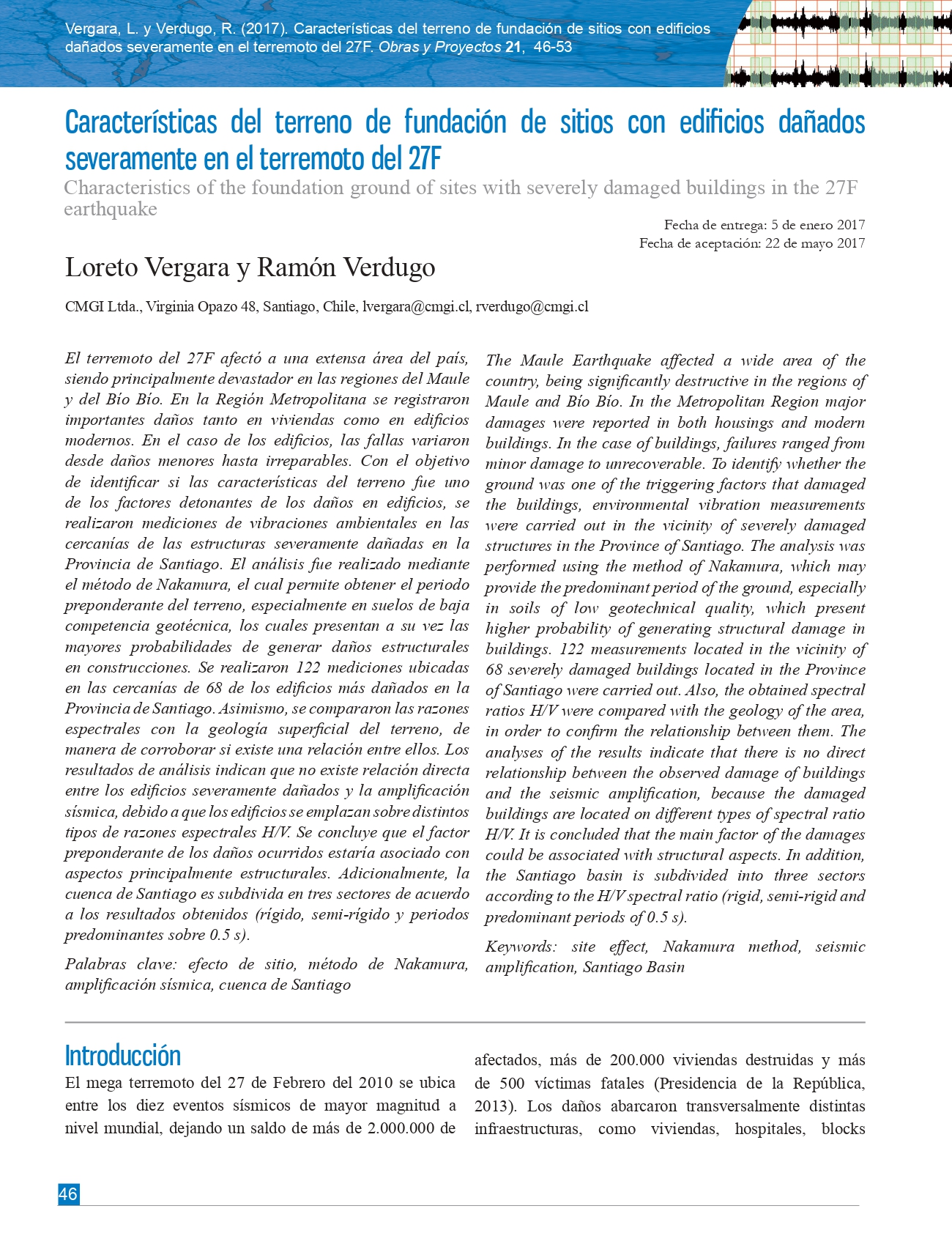Characteristics of the foundation ground of sites with severely damaged buildings in the 27F earthquake
DOI:
https://doi.org/10.4067/S0718-28132017000100006Keywords:
site effect, Nakamura method, seismic amplification, Santiago BasinAbstract
The Maule Earthquake affected a wide area of the country, being significantly destructive in the regions of Maule and Bío Bío. In the Metropolitan Region major damages were reported in both housings and modern buildings. In the case of buildings, failures ranged from minor damage to unrecoverable. To identify whether the ground was one of the triggering factors that damaged the buildings, environmental vibration measurements were carried out in the vicinity of severely damaged structures in the Province of Santiago. The analysis was performed using the method of Nakamura, which may provide the predominant period of the ground, especially in soils of low geotechnical quality, which present higher probability of generating structural damage in buildings. 122 measurements located in the vicinity of 68 severely damaged buildings located in the Province of Santiago were carried out. Also, the obtained spectral ratios H/V were compared with the geology of the area, in order to confirm the relationship between them. The analyses of the results indicate that there is no direct relationship between the observed damage of buildings and the seismic amplification, because the damaged buildings are located on different types of spectral ratio H/V. It is concluded that the main factor of the damages could be associated with structural aspects. In addition, the Santiago basin is subdivided into three sectors according to the H/Vspectral ratio (rigid, semi-rigid and predominant periods of 0.5 s).
References
Araneda, M., Avendaño, M. y Merlo, C. (2000). Modelo gravimétrico de la cuenca de Santiago, etapa III final. IX Congreso Geológico de Chile, Puerto Varas, Chile, 2, 404-408
Fernández, J.C. (2003). Respuesta sísmica de la cuenca de Santiago. Servicio Nacional de Geología y Minería. Carta Geológica de Chile. Serie Geología Ambiental N°1
Fernández, J.C. (2001). Estudio geológico-ambiental para la planificación territorial del sector Tiltil - Santiago. Memoria de título de Geólogo, Universidad de Chile
Fock, A. (2005). Cronología y tectónica de la exhumación en el Neógeno de Los Andes de Chile Central entre los 33°y los 34° S. Tesis de Magíster, Universidad de Chile
Konno, K. and Ohmachi, T. (1998). Ground-motion characteristics estimated from spectral ratio between horizontal and vertical components of microtremor. Bulletin of the Seismological Society of America 88(1), 228-241. https://doi.org/10.1785/BSSA0880010228
Leyton, F., Sepúlveda, S., Astroza, M., Rebolledo, S., González, L., Ruiz, R., Foncea, C., Herrera, M. y Lavado, J. (2010). Zonificación sísmica de la cuenca de Santiago. X Congreso Chileno de Sismología e Ingeniería Antisísmica. ACHISINA, Santiago
Massone, L. y Rojas, F. (2012). Comportamiento de edificios de hormigón armado. En Mw = 8.8 Terremoto en Chile. 27 de febrero 2010. Universidad de Chile
Milovic, J.J. (2000). Estudio geológico-ambiental para el ordenamiento territorial de la mitad sur de la cuenca de Santiago. Memoria de título, Universidad de Concepción
Nakamura, Y. (2008). On the H/V spectrum. The 14th World Conference on Earthquake Engineering, Beijing, China
Nakamura, Y. (1989). A method for dynamic characteristics estimation of subsurface using microtremor on the ground surface. Quarterly Reports of the Railway Technical Research Institute 30(1), 25-33
Pastén, C. (2007). Respuesta sísmica de la cuenca de Santiago. Tesis de Magíster, Universidad de Chile
Presidencia de la República (2013). La reconstrucción de Chile. Colección Memoria Presidencial. Santiago, Chile
Rauld, R. (2002). Análisis morfoestructural del frente cordillerano Santiago Oriente, entre el río Mapocho y quebrada de Macul. Memoria de título de Geólogo, Universidad de Chile
Sellés, D. y Gana, P (2001). Geología del área de Talagante-San Francisco de Mostazal, regiones Metropolitana de Santiago y del Libertador General Bernardo O'Higgins. Servicio Nacional de Geología y Minería. Carta Geológica de Chile. Serie Geológica Básica, N°74
SESAME (2004). Site effects assesment using ambient excitations. Report on Simulation for real sites. European Commission - Research General Directorate
Valenzuela, G. (1978). Suelo de fundación de Santiago. Instituto de Investigaciones Geológicas. Boletín N°33
Vergara, L. (2015). Relación entre las propiedades geológicas y geotécnicas de la cuenca de Santiago y los daños observados en el terremoto del 27 de Febrero del 2010. Tesis de Magíster, Universidad de Chile
Vergara, L. y Verdugo, R. (2014). Condiciones geológicas-geotécnicas de la cuenca de Santiago y distribución de daños del terremoto del 27F. VIII Congreso Chileno de Ingeniería Geotécnica, SOCHIGE, Santiago
Wall, R., Sellés, D. y Gana, P. (1999). Área Tiltil-Santiago, Región Metropolitana. Servicio Nacional de Geología y Minería. Mapas Geológicos N°11

Downloads
Published
Issue
Section
License
Copyright (c) 2017 Universidad Católica de la Santísima Concepción

This work is licensed under a Creative Commons Attribution-NonCommercial 4.0 International License.







